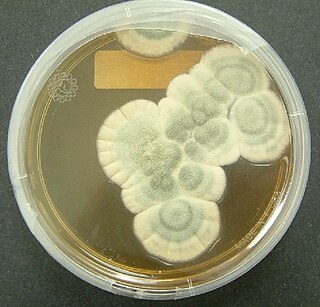
Penicillium chrysogenum is a species of fungus in the genus Penicillium. It is common in temperate and subtropical regions and can be found on salted food products, but it is mostly found in indoor environments, especially in damp or water-damaged buildings. It has been recognised as a species complex that includes P. notatum, P. meleagrinum, and P. cyaneofulvum. Molecular phylogeny has established that Alexander Fleming's first discovered penicillin producing strain is of a distinct species, P. rubens, and not of P. notatum. It has rarely been reported as a cause of human disease. It is the source of several β-lactam antibiotics, most significantly penicillin. Other secondary metabolites of P. chrysogenum include roquefortine C, meleagrin, chrysogine, 6-MSA YWA1/melanin, andrastatin A, fungisporin, secalonic acids, sorbicillin, and PR-toxin.

Penicillium rubens is a species of fungus in the genus Penicillium and was the first species known to produce the antibiotic penicillin. It was first described by Philibert Melchior Joseph Ehi Biourge in 1923. For the discovery of penicillin from this species Alexander Fleming shared the Nobel Prize in Physiology or Medicine in 1945. The original penicillin-producing type has been variously identified as Penicillium rubrum, P. notatum, and P. chrysogenum among others, but genomic comparison and phylogenetic analysis in 2011 resolved that it is P. rubens. It is the best source of penicillins and produces benzylpenicillin (G), phenoxymethylpenicillin (V) and octanoylpenicillin (K). It also produces other important bioactive compounds such as andrastin, chrysogine, fungisporin, roquefortine, and sorbicillins.
Penicillium adametzii is an anamorph fungus species of the genus of Penicillium.
Penicillium adametzioides is an anamorph fungus species of the genus of Penicillium, which was isolated from decayed Grapes in Cheongsoo in Korea.
Penicillium cremeogriseum is an anamorph species of the genus of Penicillium which produces fulvic acid. Penicillium cremeogriseum was isolated from forest soil in Kyiv, Ukraine.
Penicillium donkii is an anamorph species of the genus of Penicillium.
Penicillium erubescens is an anamorph species of the genus of Penicillium.
Penicillium erythromellis is an anamorph species of the genus of Penicillium.
Penicillium gracilentum is a species of the genus of Penicillium.
Penicillium griseolum is an anamorph species of the genus of Penicillium.
Penicillium inflatum is an anamorph species of the genus of Penicillium which produces sterigmatocystin. It is from the Cremei section.
Penicillium kananaskense is an anamorph species of the genus of Penicillium which was isolated from soil of a forest in Alberta in Canada.
Penicillium allahabadense is an anamorph species of the genus of Penicillium which produces rugulosin.
Penicillium lacus-sarmientei is an anamorph species of the genus of Penicillium which was isolated from soil of the shores of the Lake Sarmiento in the Chilean Tierra del Fuego.
Penicillium ludwigii is an anamorph species of the genus of Penicillium.
Penicillium mononematosum is an anamorph species of the genus Penicillium which produces viriditoxin.
Penicillium nalgiovense is an anamorph species of the genus Penicillium with lipolytic and proteolytic activity, which was first isolated from ellischau cheese. This species produces dichlorodiaportin, diaportinol, and diaportinic acid Penicillium nalgiovense is used for the maturation of certain fermented salami varieties and ham. In this process it protects the meat from colonization by other molds and bacteria
Penicillium nordicum is an anamorph species of fungus in the genus Penicillium which produces ochratoxin A. Penicillium nordicum contaminates protein rich foods and foods with high NaCl-konzentration. It is mostly found on dry-cured meat products and cheese products
Penicillium roseopurpureum is an anamorph species of fungus in the genus Penicillium which produces Carviolin.
Aspergillus brevipes is an anamorph species of fungus in the genus Aspergillus. It is from the Fumigati section. It was first described in 1952. It has been isolated from soil in Australia. Aspergillus brevipes produces roquefortine C, meleagrin and viriditoxin.

